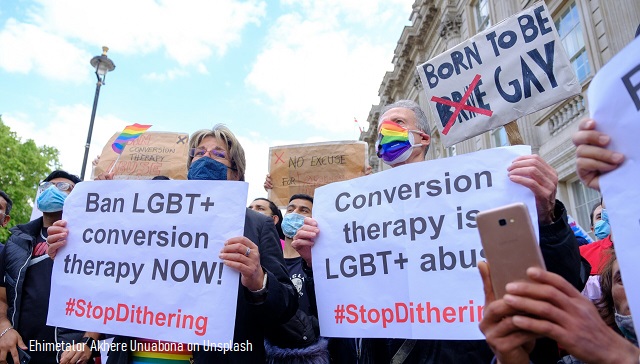Where is the evidence that ‘conversion therapy’ is harmful?
By MercatorNet – Navigating Modern Complexities

An American sociologist crunched the numbers and came up with surprising conclusions.
Fifty-five-year-old Chris Butler told the BBC yesterday that he had suffered years of trauma after “gay conversion therapy” when he was 19. Church elders handed him over to men who pinned him to the floor, placed a huge Bible on his head, and performed an exorcism.
Mr Butler says that it took him 12 years to recover from the ordeal.
Stories like these are flooding the zone in the English and Scottish press at the moment because Westminster, in London, and Holyrood, in Edinburgh, are both determined to legislate for comprehensive bans on “conversion therapy”.
“We are committed to building a society in which conversion therapy no longer takes place,” says the UK Minister for Women and Equalities, Liz Truss.
World-wide popularity
Whether or not “conversion therapy” bans are necessary, there’s no denying that for legislators around the world, they are catnip.
The United Nations called for a global ban on conversion therapy in 2020 because it is “inherently degrading and discriminatory” and “inflict[s] severe pain and suffering, resulting in long-lasting psychological and physical damage”.
The French National Assembly unanimously passed a ban last month. Canada’s lower house passed a ban in December, also unanimously. Other countries with bans include Brazil, Ecuador, Malta, Albania and Germany. In Australia, the jurisdictions of Queensland, the ACT and Victoria have passed bans. In the United States, 28 states have effectively banned it.
Where is the evidence of harm?
Just two small problems.
First, in 2022, what is “conversion therapy”? The kind of abusive violence that Chris Butler experienced 35 years ago no longer happens – at least in the countries which are banning it. And the historic abuse which is being used to justify “conversion therapy” of any kind, even “talking therapy”, is hardly relevant to the situation of trans teenagers nowadays.
The UK’s Equality and Human Rights Commission, which lobbies for gays, lesbians, and bisexuals, is very sceptical about the government’s plans. “You can’t legislate without definitions or evidence. And why should anyone want to try?” was the scathing response of Bev Jackson, a founding member of the Gay Liberation Front.
Second, where is the peer-reviewed expert proof that “talking conversion therapy” is harmful? The UK government declares in its report that it plans to criminalise this for people under 18.
A lot is at stake. The terms of the various laws vary, but some of them would prevent psychologists, pastors, or even parents from dissuading children from a belief that they are gay or lesbian or trans. “We are witnessing the criminalisation of parental love,” wrote UK journalist Brendan O’Neill in Spiked. “ And even The Economist, which normally supports the demolition of moral taboos, is strongly opposed to the UK government’s plans. “For some trans-identified patients, drugs and hormone treatments will be the right outcome. But for many others, perhaps most, they may not. That is why talking therapies must be available in treatment.”
So where is the evidence that “conversion therapy” — or to use a less emotive term, sexual orientation change efforts (SOCE) — is harmful?
Extraordinary claims need extraordinary evidence
An article published this week in a leading peer-reviewed journal, Frontiers in Psychology, claims that there is none. American sociologist Paul Sullins states bluntly that “even for persons for whom SOCE has had no efficacy, there is no discernible psychosocial risk”.
Sullins analysed data from the Generations study gathered by the Williams Institute, an LGBT thinktank in California. This is the first long-term, five-year study to examine the health and well-being across three generations of American lesbians, gay men, and bisexuals.
He compared SOCE alumni — people who have undergone “conversion therapy” — with non-SOCE LGB persons. Astonishingly, for anyone informed only by the overheated media coverage, he found no difference between the two groups for several measures of behavioural harm, including suicidal morbidity, psychological distress, self-harm (cutting), and substance abuse.
True, SOCE alumni probably did experience stress and stigma over their lifetimes – but they did not fare worse than the non-SOCE group. Even in measures like internalised homophobia and the number of days of poor mental health in the past month there was no difference. There was at least one difference — they were more likely to be out about their sexuality.
Bold claims – but the UK government’s own report candidly admits that the evidence base is very weak.
How widespread is “conversion therapy”? The government won’t say:
“it is difficult to estimate the true prevalence of conversion therapy among LGBT people in the general population.” Does it harm people? There is “a growing body of quantitative evidence” – in other words, there’s not much. Can we trust the qualitative evidence? — “the evidence base for conversion therapy is predominantly based on self-reporting and care needs to be taken when examining the impact of conversion therapy.”
A fresh look at the data
Most people believe that “conversion therapy” is always and everywhere wrong , so the no-harm theory requires some unpacking.
From a policy perspective, the real question is not whether a gay or lesbian person has memories of a stressful experience, but whether its effects were truly long-lasting. It’s important to bear in mind that someone who seeks out therapy is already troubled.
Sullins found that: “Those who had undergone SOCE were no more likely to experience psychological distress or poor mental health, to engage in substance or alcohol abuse, to intentionally harm themselves, or to think about, plan, intend or attempt suicide, than were those who had not undergone SOCE.”
Sullins acknowledges that several studies have reported harm following SOCE, particularly increased suicidal behaviour. But only four of these used a random sample and all four failed to distinguish suicidal behaviour before and after SOCE. Sullins’s study, on the other hand, is based on 1,518 people who self-identified as LGB in a Gallup survey of 350,000 American adults.
He found that suicidal behaviour is much higher before SOCE (which probably prompted request for therapy) but not afterward. In fact, in a forthcoming critique of an influential study by gay suicide expert John Blosnich, Sullins argues that people who have experienced SOCE are less inclined to commit suicide:
“Experiencing SOCE therapy does not encourage higher suicidality, as they claim; rather, experiencing higher suicidality appears to encourage recourse to SOCE, which in turn strongly reduces suicidality, particularly initial suicide attempts. Restrictions on SOCE deprive sexual minorities of an important resource for reducing suicidality, putting them at substantially increased suicide risk.”
Let that sink in. If Sullins is right, depriving LGB people of the possibility of seeking therapy could lead to more suicides, not fewer.
Science without evidence is bunk
Extraordinary claims require extraordinary evidence. It is extraordinary that the UK government is contemplating the criminalisation of talking therapies. Common sense suggests that people need to talk about their sexual anxieties. Where is the extraordinary evidence that common sense is wrong?
“A habit of basing convictions upon evidence, and of giving to them only that degree or certainty which the evidence warrants, would, if it became general, cure most of the ills from which the world suffers,” said Bertrand Russell.
Unfortunately, virtue signalling is higher on the list of Liz Truss’s priorities than gathering evidence. She says bluntly: “it is the view of the government that one incident of conversion therapy is too many.”

This article is courtesy of DrRichSwier.com, an online community of citizen journalists, academics, subject matter experts, and activists to express the principles of limited government and personal liberty to the public, to policy makers, and to political activists. Please visit DrRichSwier.com for more great content.

